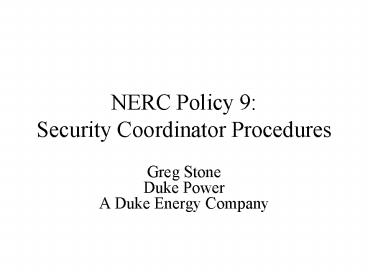NERC Policy 9: Security Coordinator Procedures PowerPoint PPT Presentation
1 / 13
Title: NERC Policy 9: Security Coordinator Procedures
1
NERC Policy 9Security Coordinator Procedures
- Greg Stone
- Duke Power
- A Duke Energy Company
2
NERC Policy 9 Security Coordinator Procedures
- Definitions
- Origins
- History
- Recent Developments
- Review Policy Sections
- Future
3
NERC Policy 9 Security Coordinator Procedures
- Definitions
- CA Control Areas
- FERC Federal Energy Regulatory Commission
- NERC North American Electric Reliability Council
- PSE Purchasing Selling Entity
- TLR Transmission Loading Relief
- TP Transmission Provider
4
NERC Policy 9 Security Coordinator Procedures
- Origins
- Result of NERC Initiatives adopted to address
rapidly evolving industry - Interim Policy adopted for summer, 1997
- Initially only addressed parallel flows
- Prompted by several near misses in 1996
5
NERC Policy 9 Security Coordinator Procedures
- History
- Summer 1997 Develop TLR procedures tools for
implementation - iIDC, TLR Client - Spring, 1998 FERC rules on NSP filing
- June 5, 1998 NERC files TLR with FERC
- June 12, 1998 FERC rules use OK, for now
6
NERC Policy 9 Security Coordinator Procedures
- History (cont.)
- September, 1998 Policy 9 becomes official
- October, 1998 NERC refiles TLR with FERC
- December 16, 1998 FERC TLR Order
7
NERC Policy 9 Security Coordinator Procedures
- Recent Developments
- Policy 9 out for Due Process
- FERC TLR Order
- NERC must file TLR
- NERC must respond to fundamental questions
- TPs must file intention to amend tariff to
include TLR - TPs must file plans to address comparability
issues for this summer
8
NERC Policy 9 Security Coordinator Procedures
- Policy Review
- A. Next Day Operations
- B. Current Day Operations - Generation
- C. Current Day Operations - Transmission
- All subject to change
9
NERC Policy 9 Security Coordinator Procedures
- Policy Review
- A. Next Day Operations
- Exchange of operational information
- System Studies
- Communication of identified problems
10
NERC Policy 9 Security Coordinator Procedures
- Policy Review
- B. Current Day Operations - Generation
- Generation Deficiency Alerts
- Level 1 - May not have required reserves
- Level 2 - Emergency Procedures
- Level 3 - Firm load curtailment
11
NERC Policy 9 Security Coordinator Procedures
- Policy Review
- C. Current Day Operations - Transmission
- Transmission Loading Relief
- Share the Pain
- Moving from Weakest Link to Constrained Path
- Dependent on proper tags/tagging
information/electronic tagging - Constrained Path due for implementation after all
electronic tagging - June, 1999 - What is Constrained Path Methodology
12
NERC Policy 9 Security Coordinator Procedures
- Policy Review (cont.)
- C. Current Day Operations - Transmission
- Transmission Loading Relief
- Level 1 Warning of Potential Problem
- Level 2 Approaching limit - Hold additional
business - Level 3 Overload - Reduce non-firm business
- Level 4 Overload - Redispatch or Reconfigure
- Level 5 Overload - Reduce firm business
- Level 6 Overload - Emergency Actions
- Level 0 Return to Normal
13
NERC Policy 9 Security Coordinator Procedures
- Policy Review (cont.)
- C. Current Day Operations - Transmission
- Publicly Available Information
- Distribution Factor Viewer
- Real Time Log
- Historical Log
- Market Redispatch Pilot

